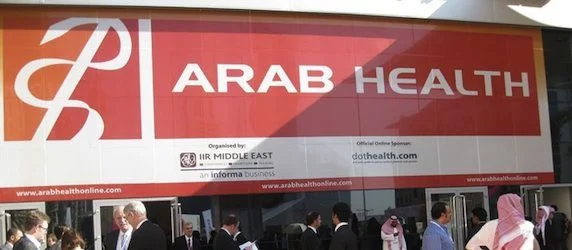Record breaking visitor numbers expected at Arab Health Exhibition & Congress as 400 additional exhibitors are showcased in the new hall
A record breaking number of healthcare trade professionals are expected to attend the 39th Arab Health Exhibition & Congress which was inaugurated this morning by HH Sheikh Hamdan bin Rashid Al Maktoum, Deputy Ruler of Dubai and UAE Minister of Finance & Industry at the Dubai International Convention & Exhibition Centre.
The four day event, which continues on 28-30 January, welcomed the addition of the brand new ‘Za’abeel 4’ hall which accommodates 400 additional exhibitors, bringing together a total of 3,900 exhibiting companies from 64 countries, and 38 country pavilions, all showcased over 65,677 sqm of exhibition space.
Commenting at the event’s opening, Simon Page, Managing Director, Informa Life Sciences Exhibitions said: “Arab Health is at the heart of the region’s healthcare, and for a very valid reason. With the UAE healthcare market alone expanding by almost 100% last year and recent reports suggesting it is on a path to becoming a Dhs4 billion industry by 2018, there is no better time or place to host one of the foremost healthcare trade events in the world.”
The event’s already established country pavilions, such as the US and Chinese pavilions remain heavyweights in terms of size. The Chinese pavilion has 510 Chinese exhibitors in comparison to 420 exhibitors for last year. The US pavilion, with more than 215 companies (12% more exhibitors than in 2013), is the largest American group ever to assemble at Arab Health in its 20th consecutive year of attending.
Other new features for the 39th edition of the show include the newly launched Training Village, where top specialists in the healthcare sector, such as Philips, Siemens, Samsung, Boston Children’s Hospital, Hill-Rom, G-MEA Association and Johnson & Johnson are running hands-on training sessions on the most sophisticated and up-to-date devices.
The world’s largest multi-track series of healthcare conferences, the Arab Health Congress, is anticipating more than 10,000 delegates over the next four day.
A much awaited highlight from this year’s Congress was the keynote address from Professor Maha Barakat, Director General, Health Authority–Abu Dhabi (HAAD), who spoke this morning about the most recent Diabetes Guideline for the Middle East.
According to Professor Barakat, “If we look at statistics on the top 10 countries in terms of absolute numbers of people with diabetes, only Egypt is among the top 10 with 7.5 million people with diabetes. However, if we look at the prevalence of diabetes as a percentage of population, then we will find Kuwait, Saudi Arabia, Qatar and Bahrain among the top 10 list. The UAE is no longer in the top 10 per capita, and is now 15th worldwide, according to latest estimates from the International Diabetes Federation (IDF).”
For Diabetes management, the Health Authority–Abu Dhabi recommends that all physicians look at major international guidelines, such as the IDF Guidelines and the American Diabetes Association (ADA) Recommendations. The IDF is ingenious at being able to cover the whole spectrum of countries, even those that are under-resourced. The advantage of this approach is that these guidelines can also be helpful to physicians within a country where insurance may not cover diagnostic tests as well as when a patient does not have money to pay out of pocket.
Regarding the ADA 2014 revisions, “the ADA has given an alternate method to diagnose diabetes arising in pregnant women (known as Gestational Diabetes, GDM). In last year’s Recommendations, the ADA introduced the 2013 criteria, and admitted that these strict criteria would significantly increase the diagnosis of GDM. This year the alternate method for diagnosis of GDM is based on the National Institute of Health (NIH) consensus. This recent addition gives the option of a simpler test and does not rely on the fasting glucose of the women. The 2013 method is still offered as an option, however, now we have another method which I believe is simpler and less likely to earmark women as having problems in pregnancy. This in turn will allay the increasing anxiety in pregnant women and will also help with waiting times in clinics,” adds Professor Barakat.
Source: Arab Health
27 January 2014
Latest Articles
Guidelines, Congresses, Arab Health, Arab Health 2014, conference, exhibition
Record breaking visitor numbers expected at Arab Health Exhibition & Congress as 400 additional exhibitors are showcased in the new hall A record br...










